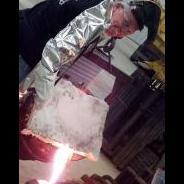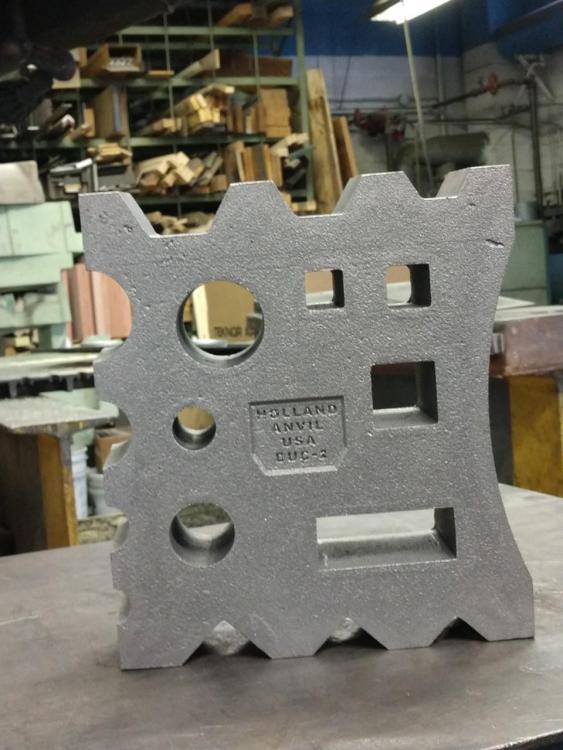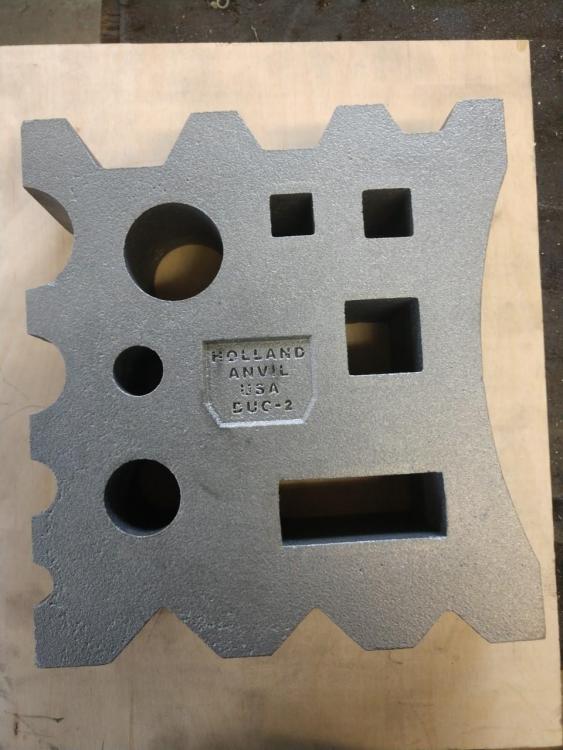-
Posts
132 -
Joined
-
Last visited
Content Type
Profiles
Forums
Articles
Gallery
Downloads
Events
Posts posted by foundryguy
-
-
On 4/21/2020 at 10:05 PM, Benona blacksmith said:
Absolutely not. Cast iron ASO's are dangerous as is an anvil that's too hard. A piece can fracture off and hurt someone badly. I dont even like my 250 lb cast iron swage block for the same reason. My buddy got hit in the chest with a piece of my swage block. I much rather use my Holland anvils swage black that's a ¼ the weight.
You need to visit us in Holland sometime, we have a lot of new things going on
-
It should be noted that a couple of the manufacturers listed as USA import their castings from China or other 3rd world countries. They are sold in the USA but not manufactured here. Hopefully some people still care about domestic manufacturers. Buy American!
-
Great that you put this list together! We are proud to be a part of it! Cheers
-
Hey Gents, i make the Holland Anvil tools. We produce H13 tool steel anvils and ductile swage blocks and cone mandrels. If anyone has questions you can message me or I would be happy to reply in this thread. Cheers!
-
On 10/13/2019 at 12:21 PM, Dave Van Antwerp said:
If you are getting your full asking price, does it really matter if someone else sells it for more? It's American capitalism at its finest in my opinion. They have access to customers you don't, willing to pay more for your product.
Dave, it matter to me! If I wanted a middle man on my Holland Anvil tools I would get a Blacksmith Supply shop to sell them, they have all asked. We had people paying $100 for a block on Ebay over our sale price, not a good situation in my opinion. Amazon had a group in Taiwan selling our blocks in the states, you payed Amazon and they placed the order and we shipped them out in the US not knowing anything about it. Somehow they made $300 per block per sale. Anyway, if someone sells their single tool at a markup fine, but its really about dishonest people trying to make a living from our hard work. Everyday we run into great people, occasionally liars and cheats.
You should post a photo of your wood anvil art on this forum, I think these folks would enjoy it.
Cheers!
-
I make Holland Anvil products at my company that my grandfather started in 1943. We currently make 9 different anvils in 3 styles all made of cast H13 tool steel. Our anvils are hardened 100%, not surface hardened. The bottom is as hard as the top. We make our own patterns and pour our castings in house and only sell direct to the public, no middle men or blacksmith supply shops involved.
If you are buying new please consider buying American products and direct from the manufacturer. If not my tools consider one of the other folks that are doing this for the right reasons, love of producing quality tools for blacksmiths.
Cheers to all
-
17 hours ago, jwmelvin said:
I just ordered a Holland 140. Best of both worlds hopefully, and I’m excited to start this new hobby... (and I do realize how much overkill it is)
Thank you for the order JM! We are shipping it today! Cheers
-
I better cut another pattern for you!
-
A foundrymans perspective on heat treat.
If you are going to heat treat a modern steel anvil I would suggest sending it out to a heat treat shop and having them get it right. The difference in a couple points on the Rc scale is huge. One thing you need to determine is actual chemistry, possibly by hitting it with a gun that most heat treat shops have or a high end scrap yard. I would verify what a producer says the material should be. A proper quench and temper might cost you $.50 per lb and you would want to get it shot blasted to remove the scale. You should be able to clean the top deck with a sander and re-polish the horn. Scale can be substantial with a hardening process. This would be for a cast or forged steel anvil. Ductile would be different process and an expensive one to do it correctly.
Our H13 Holland Anvil tools are done by Cryogenic hardening. We out source the process. Tools are put into a vacuum furnace and quenched with liquid nitrogen, then tempered down to the proper hardness. Scale is minimal in a vacuum operation. When we started the price was $1.10 per lb, now I get a "deal" at $.93 per lb. The heat treat is a tough bill to pay but for H13 its what we need to do.
-
I should have a casting to show next week. I will tag you when i post a pic.
-
Hey Dan, thank you for checking us out. We put them on Ebay as others were reselling them there at a large markup. It has been a good way to reach people that normally would not find our products and put an end to online sellers. We add a bit of $ to the price as Ebay takes a pretty good cut of sales. My son did the website, we launched it last week and had our first sale on it yesterday. We make everything ourselves, outsource the heat treat and blanchard grinding on the anvils. Our blocks are right from the foundry and you may wish to polish them up or use as is. Have a great day!
btw, we have a double shovel swage block coming out next week!
-
Branson,
It was good talking with you! I sign on here at least once a week but typically get an email if i receive a message so i try to respond quickly. I appreciate everyone's support. Buy American!
-
Its Greg from Holland. Feel free to message me here and we can email you any information you need or chat on the phone. Cheers
-
Hey Mitch, i saw our Holland anvils mentioned in this discussion. I looked back at your message and it was after 11 PM local time or you would have had a reply in under an hour. Once we switch over to a website and emails the replies will not be as timely as they are now on messenger. As far as Nimba and Hoffman anvils go, I appreciate you including us in such fine company. Buy American made and thanks again for the consideration.
-
3 hours ago, FlatLiner said:
I like it foundryguy. What is the projected price for it?
We have been asked not to talk price on this forum. Just showing off my new design
-
-
23 hours ago, JHCC said:
That does it for me -- if I ever get a new anvil, it's going to be a Holland.
Thank you for the mention or our Holland tools! The dimples look like ours do bouncing on a non hardened anvil, we probably get 40% rebound along with a thunk. A hardened anvil may leave a small mark depending on the size of the ball but nothing like that. I had a guy show up with a 2 inch ball wanting to bounce it around and i said, buy if first if you want to use that. Like a hammer blow, a quality hardened tool can leave a mark. I also do not understand the course grain in the photo, its more a characteristic common in ground cast iron or ductile when it is machined, not steel, especially an alloyed material. I do not knock anyone's products but that is an odd photo in many ways.
-
shoot, i forgot to add the weight. They are 66.5 lbs. I hope you enjoy the cone!
-
I shared a photo in my other thread but thought I would share the new design and details of the shapes. The top left corner is beefed up a bit from the prototype. I am designing a 14 x 14 x 3 block in the coming months as well which will have many more features and a shaping bowl in the center. That block will not have side designs, only holes, squares and slots
11.25 inch x 10 inch x 3 inch thick
Cast holes are smooth and are straight with no draft. Sides have 1 degree draft for molding
Slot is 1.25 inch x 3.25 inch
Rounds are 1 inch, 1.5 inch and 2 inch diameter
Squares are 7/8 inch, 1 inch and 1.5 inch
Exterior 90% Vs are 1.5 inch, 1.75 inch and 2 inch
Exterior rounds are 2 inch, 1.5 inch, 1.25 inch and 1 inch
Exterior Hex is 2.5 inch, 2 inch, and 1.5 inch
These castings are rough cast and can be used as is or after your polish or customization
Material is 65-45-12 ductile iron
-
We are making a change to the top left corner of the block but other than that the tool is done. My son drew it up and replacement would set us back weeks or months as my tool shop has a 3 month backlog. I think at 3 inches thick it will be plenty stable? We have a 14 x 14 x 3 block in the works and that gives us a lot more room for design ideas. Have a great day.
-
This is my sons latest swage block. He forwarded me this photo and i do not have size details other than it is 63 lbs and 3 inches thick. He is making one small change to the tool on Monday, adding 3/8 height so there is a bit more separation between the large hex and large round as i did not like the narrow condition between them. Sides are tapered for molding, all holes are cored without draft. The final version should be 67 lbs and I will post details with sizes of features next week.
Happy Thanksgiving
-
Walter,
I came across this dialogue mentioning my Holland Anvils. I wanted to thank you for considering us and congratulate you on your purchase of the Peddinghaus, those are an awesome tool. I am also writing because i noticed you are from Nelson, what a cool place. I have been there several times on ski adventures. It is one of my favorite areas in Canada. Hippies, curling and the Kootenays.
Thanks again for considering us and mentioning us in good company. Hopefully in the future we can dial in affordable Canadian shipping, some inventory and even a Website.
Cheers and think snow!
-
On 10/28/2018 at 11:27 PM, MotoMike said:
JHCC and JPL, thanks
Mike, the material is quite but simple to polish, cut, machine, drill and tap. We debated on what to put on the bottom as a mount but a 1 inch without draft seemed to be the way to go. We have seen a few people hold them in a vice for their needs as well.
-
10 hours ago, BIGGUNDOCTOR said:
I always thought that cones could be made as a byproduct of casting the anvil. Pour the anvil and the sprue is in the shape of the mandrel. Cut the sprue off and you have a cone to go with the anvil.
Someone probably did that back in the day. Our down sprues are straight, not tapered, probably useful to someone for something but nothing that I would wish to sell with my name attached to it. We are a production shop focused on quality product for our customers, including the blacksmith tools.


.thumb.jpg.b5316f99a2d7df16171dd249acec2cb2.jpg)


Show me your anvil
in Anvils, Swage Blocks, and Mandrels
Posted
Our newest anvil at Holland Anvil. H13, 55 Rc, 235 lbs. This tool is 33.5 inches long and 3.875 wide.